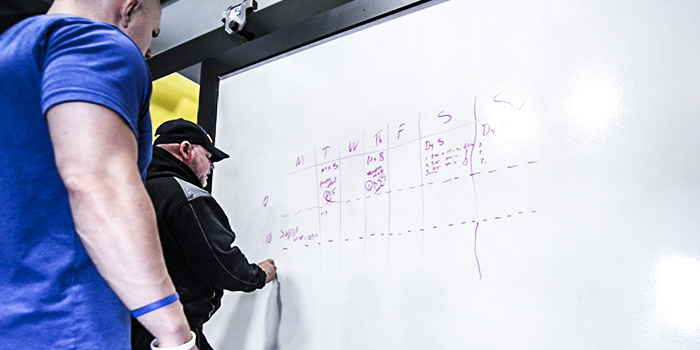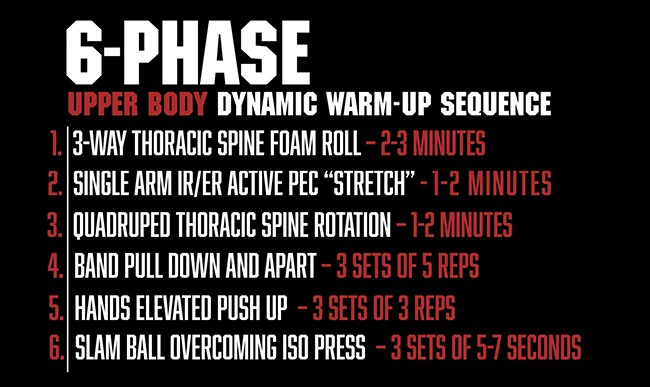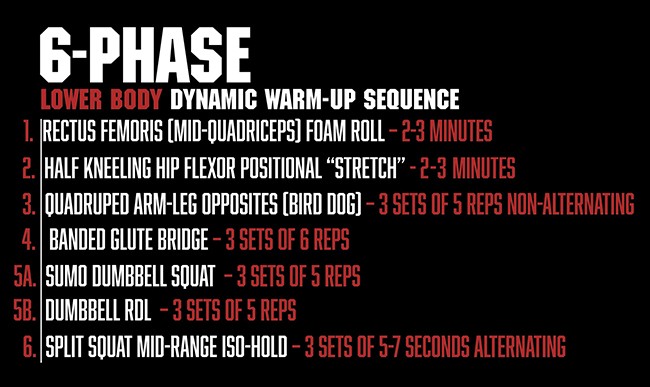
Editor's Note: Fixing Dave Tate is an educational video series intended for demonstration purposes only (acts as a case study specific to Dave Tate). It is not intended to medically diagnose, treat, or manage symptoms. If you are in pain, please consult a licensed healthcare professional.
In the previous video of the Fixing Dave Tate series, Dr. Rusin observed Dave's current training capabilities and began preparing a plan to address their three identified areas of focus. The first alteration to Dave's training is now explained in this video, which details the six-phase dynamic warm-up sequences Dr. Rusin has created for Dave. The goal is to rebuild Dave's foundational movement patterns, and the first step of accomplishing this is a six-phase warm-up sequence for each training day. These sequences include components for:
- Soft tissue
- Positional stretching
- Corrective movement
- Muscle and movement activation
- Foundational movement pattern development
- Central nervous system stimulation
These sequences serve as prehabilitation and rehabilitation while also providing a comprehensive warm-up. The goal is to get through each sequence in less than 15 minutes at the start of each session. With Dave's current training setup, he has two lower body training days and two upper body training days. This means that he will have two different warm-up sequences that he will perform twice each per week: a lower-body sequence and an upper body sequence, each performed on the two respective training days. Over time, the repetitive and extended exposure to these sequences will pay dividends in rebuilding Dave's movement and reducing his experience of pain.
Dr. Rusin begins by explaining that the six-part sequence is broken up into three two-part blocks. The first two parts of the sequences (soft tissue and positional stretching) are about the parasympathetic response, being most important on days that Dave is mentally charged to train. They work to help take Dave from a sympathetic level and bring him down to a normalized state. Conversely, the third and fourth parts of the sequences (corrective movement and muscle and movement activation) are about jacking Dave up and increasing his sympathetics on days he isn't entirely ready for the session. The fifth and sixth parts (foundational movement pattern development and central nervous system stimulation) are for the days Dave feels perfect — not too stimulated or under-stimulated. Dr. Rusin gives further detail on each of the six parts to explain what types of activities will be performed for each of them.
With each of these six components in mind, Dr. Rusin gives the specific six-phase dynamic-warm-up sequences for both upper and lower body training days. He first shares the upper body sequences. The number one goal, Rusin reminds, is to open the thoracic spine, reeducate the scapula, and get it to work better to take pressure off Dave's right shoulder to enable use of it. Based on that, Rusin explains the purpose of each of the following movements in the six-phase upper body dynamic warm-up sequence:
Dr. Rusin then shifts his attention to the six-phase lower body warm-up sequence. Because the goal here is to help activate the posterolateral hip group—which is currently experiencing a "neural lock"—this sequence focuses on split stance movements and ground-based contacts With this goal in mind, the sequence includes the following movements, which Dr. Rusin explains individually:
With the warm-up sequences laid out, Dave explains his training setup and how these sequences will be integrated into his system. This is, in essence, a Westside style approach based on three-week phases of the dynamic effort work. His weekly schedule is designed as:
- Monday — Off
- Tuesday — Max Effort Squat
- Wednesday — Off
- Thursday — Max Effort Bench Press
- Friday — Off
- Saturday — Dynamic Effort Squat
- Sunday — Dynamic Effort Bench Press
Dave goes into detail about the specific programming for each of these training days and the way they progress by week and cycle. He explains how his max effort movements change almost every week for both squat and bench press, and his dynamic effort days wave in three-week phases. His supplemental work is typically trained hard in the five to eight rep range, with sets being determined based on how he feels. Exercises are selected on what will build "up the chain" to the main lifts. Accessory work is done in higher rep ranges (10 to 15) for up to three isolation style movements. These often included loaded iso-holds or eccentric-only final sets. Dave then discusses how he alters the components of his training over time. Max effort work is changed weekly, dynamic effort work is waved in three-week phases, supplemental work is progressed in reps, weight, or tempo every week until he can no longer progress (at most two weeks), and accessory work is changed on an until-he's-bored basis.
Dr. Rusin responds to Dave's diagram of his training by discussing the white space in the programming that they will fill. Marking up Dave's current approach, Dr. Rusin places the warm-up sequences at the beginning of the four main training days and adds a "power primer" technique that is intended to aid the posterior chain stabilizers. For the max effort squat day, this primer will be hamstrings. For the dynamic effort squat day, the primer will be glutes. For both max effort bench press and dynamic effort bench press, the primer will be upper back.
Regarding supplemental and accessory work, Dr. Rusin makes no changes to the supplemental work but alters accessory work to include orthopedic challenges at the end of the training session. These will not be heavy but will be high intensity in their demands for Dave's movement and stability capacity. On Dave's non-training days, Dr. Rusin adds cardiovascular training including aerobic and anaerobic work using a technique referred to as "flow-based sequencing." This rounds out Dave's program, which now includes work of some kind on each day of the week.
FIXING DAVE TATE SERIES
- Initial Assessment with Dr. John Rusin
- Movement Screening
- Orthopedic Evaluation
- The Three Areas of Focus Discovered During Initial Evaluation
- Observing Dave's Current Training Capabilities












2 Comments